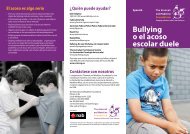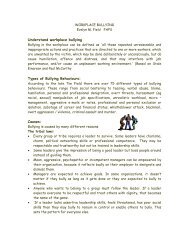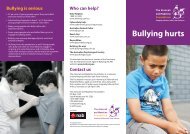The social and emotional wellbeing of students who bully different ...
The social and emotional wellbeing of students who bully different ...
The social and emotional wellbeing of students who bully different ...
Create successful ePaper yourself
Turn your PDF publications into a flip-book with our unique Google optimized e-Paper software.
Table 1.6 A Comparison <strong>of</strong> Indicators <strong>of</strong> a Positive Social Orientation for Students WhoBully with Students Who Do Not Bully (Student Survey)INDICATORS OF A POSITIVE SOCIALORIENTATIONStudents Who Bully Students Who Do NotBully52. I am good at solving conflicts without fighting. 55% 76%49. People <strong>who</strong> act unfairly are not totally bad <strong>and</strong>56% 80%it’s not OK to hurt them.53. I feel bad when other people feel hurt. 68% 70%44. I can st<strong>and</strong> behaving well/following rules. 63% 85%54. I try to make sure everyone has a fair chance to70% 81%win, even if it means I lose.32. I like helping people with problems. 73% 83%56. I try hard not to hurt other people’s feelings. 73% 87%29. I am good at underst<strong>and</strong>ing how other people77% 88%feel.*33. I care about the environment (parks, waterways)77% 88%<strong>and</strong> want to make my community a better place.40. I can be trusted to do what I say I am going to79% 91%do.27. I know how to make friends. 85% 92%35. I like to meet new people. 86% 92%30. It’s important to treat everyone including those90% 96%from <strong>different</strong> cultural backgrounds with respectImportant Note:(*) are items that only appear on Social <strong>and</strong>Emotional Well-Being Survey (Student Form –Years 5-12)(**) are items that only appear on Social <strong>and</strong>Emotional Well-Being Survey (Student Form –Years 2-4)Items in each category are ordered from highest tolowest amount that item represents <strong>of</strong> total SEWB.<strong>The</strong> comparatively low level <strong>of</strong> positive <strong>social</strong> orientation <strong>of</strong> <strong>students</strong> <strong>who</strong> <strong>bully</strong> in comparisonwith those <strong>who</strong> do not <strong>bully</strong> is strongly reinforced in the data provided by teachers (see Table1.7). According to teachers, many fewer <strong>students</strong> <strong>who</strong> <strong>bully</strong> display the <strong>different</strong> indicators <strong>of</strong> apositive <strong>social</strong> orientation (<strong>social</strong> skills <strong>and</strong> values). For example, teachers say that only 30% <strong>of</strong><strong>students</strong> <strong>who</strong> <strong>bully</strong> have good empathy skills compared with 87% <strong>of</strong> <strong>students</strong> <strong>who</strong> do not <strong>bully</strong>.In comparing student <strong>and</strong> teacher perceptions, larger percentages <strong>of</strong> <strong>students</strong> <strong>who</strong> <strong>bully</strong> say theyhave good friendship making skills (85%) in comparison with teacher ratings <strong>of</strong> friendshipmaking skills <strong>of</strong> <strong>students</strong> <strong>who</strong> <strong>bully</strong> (43%).14









